Glamoč
| Glamoč Гламоч | ||
|---|---|---|
| Municipality and town | ||
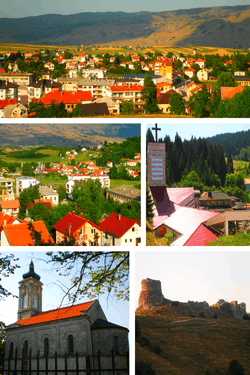 | ||
| ||
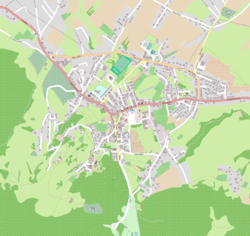 | ||
 Glamoč | ||
| Coordinates: 44°03′N 16°51′E / 44.050°N 16.850°ECoordinates: 44°03′N 16°51′E / 44.050°N 16.850°E | ||
| Country |
| |
| Entity | Federation of Bosnia and Herzegovina | |
| County | Herzeg-Bosnia County | |
| Historical region | Tropolje | |
| Government | ||
| • Municipal mayor | Radovan Marković (Alliance of Independent Social Democrats) | |
| • Local Government | Municipal Council | |
| Area | ||
| • Total | 1,033.6 km2 (399.1 sq mi) | |
| Population (2013) | ||
| • Total | 4,038[1] | |
| • Density | 3.91/km2 (10.1/sq mi) | |
| Time zone | CET (UTC+1) | |
| • Summer (DST) | CEST (UTC+2) | |
| Area code(s) | +387 34 | |
Glamoč (Cyrillic: Гламоч) is a town and municipality of the same name in western Bosnia and Herzegovina. It is in Canton 10, in the Federation of Bosnia and Herzegovina. Potatoes are a major agricultural product of the area.
History
Toponymy
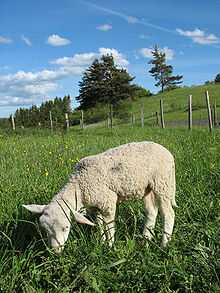
The etymology of Glamoč is uncertain. Name probably derives from the Illyrian word delma meaning sheep. Settlement was first named Delmoč, then Dlamoč and eventually Glamoč. Accordingly, the name of town indicates the area of shepherds, or a place suitable for sheep farming.
Another theory holds that the name comes from the word glama that means rocky hill.
Antiquity
Area of Glamoč has been inhabited at least since Neolithic times. In the late Bronze Age, the Neolithic population was replaced by more warlike Indo-European tribes known as the Illyrians. The region was inhabited by Illyrian tribe of Dalmatae. Their capital was Delminium which was located in today's Tomislavgrad. The Dalmatae left many remains that testify about their presence in this area. The most important remains are the gradine, remains of Illyrian settlements which were distributed along the Glamoč field. 34 gradinas were found on the territory of Glamoč.[2] The settlements were strategically well placed, that is why the Romans took over 200 years to occupy this region.
After the Roman conquest, several municipia has been established in this area that was located in the Roman province of Dalmatia. The most important of them is Salvium that existed in Illyrian times. Salvium is located 6 km away from town of Glamoč. The early Christian basilica was discovered on the territory of Salvium. The basilica was built in the 6th century, probably on the remains of a Roman temple.[3] North from Glamoč second basilica was built, probably at the same time when the basilica in Salvium was built. In the beginning this basilicas belonged to the diocese of Salona. In 533 they became part of newly established diocese in Ludrum (Knin, Croatia). Basilicas were probably destroyed during the invasion of Avars in 597.[3]
Middle Ages
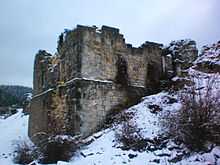
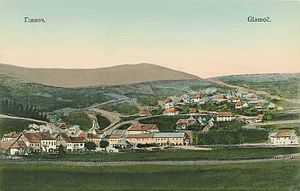
With the collapse of Roman rule in the 5th century, first barbarian tribes and then the Byzantine Empire occupied this region. In the seventh century Croats arrived and settled here. They brought Slavic culture and customs that have gradually merged with the Illyrian culture. Over the next 100 years, a Croato-Illyrian community was formed. Gradually, new settlements were formed on the hills of Glamoč Field. Main settlement was established approximately 6km to the west of Salvium, named Delmoč, or 'Town of Sheep'. After Tomislav established Kingdom of Croatia in 925, Glamoč became parish (župa) in the County of Hlivno. Therefore, the town, by the end of the 10th century, had developed all the infrastructure necessary for acquiring the status of the parish. Within the walls of the fortress church of Virgin Mary was built.[4] Nearby the town, the church of St. Catherine and the Franciscan Monastery of St. Elias were built.[5] Within the monastery Church of the Assumption of the Blessed Virgin Mary was located. The church was mentioned in 1446 when Pope Eugene IV gave it particular forgiveness.[6] The remains of the churches were found in several surrounding villages which indicates the dense population of the area. Bosnian ban Stjepan II Kotromanić conquered Glamoč and neighboring towns, Hlivno and Dlmno (Tomislavgrad) in 1326. Since then this area is called Tropolje, meaning three fields, or Završje. During the Bosnian-Hungarian war in 1357, Bosnian ban Tvrtko ceded Tropolje to the Hungarian king Louis I the Great. That same year, Grgur Stjepanić was mentioned as Lord of Glamoč. He, along with other nobles of Tropolje rebelled against the Bosnian ban so Glamoč remained under Hungarian rule until 1387. In the meantime, the ban Tvrtko was crowned as the King of Bosnia and with the help of Hrvoje Vukčić Hrvatinić he regain this area. At the end of the 14th century, Pavao Maštrović Klešić became Lord of Glamoč. Bosnian King Stjepan Ostoja took his lordship, but when he needed Pavao as ally he returned it to him in 1404.[7]
Modern history
Bosnian war
On 9 January 1992, the Bosnian Serb Assembly adopted a declaration on the Proclamation of the Republic of the Serb people of Bosnia and Herzegovina. On 28 February 1992, the constitution of the Serbian Republic of Bosnia and Herzegovina was adopted and declared that the state's territory included Serb autonomous regions, municipalities, and other Serbian ethnic entities in Bosnia and Herzegovina including Glamoč where Bosnian Serbs made 79% of population. The war in Glamoč began a few days before it started in the rest of Bosnia and Herzegovina. During January and February 1992 many Bosnian Croats and Muslims left Glamoč. Those who remained have suffered great torture done by Serbian extremists.[8] One of the first victims was a Croatian doctor Alojzije Kelava who was murdered in the city center on 24 February 1992 by Petar Vrakela, member of the Army of Republika Srpska.[9]
Settlements
• Babića Brdo • Biličić • Crni Vrh • Ćirići • Ćoslije • Dolac • Dragnjić • Dubrave • Đuličan • Glamoč • Glavica • Halapić • Hasanbegovci • Hasići • Hotkovci • Hozići • Hrbine • Isakovci • Jakir • Kamen • Karajzovci • Karlovac • Kopić • Korićna • Kovačevci • Krasinac • Malkočevci • Malo Selo • Maslina Strana • Mladeškovci • Odžak • Opačić • Perduhovo Selo • Petrovo Vrelo • Podglavica • Podgradina • Podgreda • Potkraj • Popovići • Pribelja • Prijani • Radaslije • Rajićke • Reljino Selo • Rore • Rudine • Skucani • Staro Selo • Stekerovci • Šumnjaci • Vagan • Vidimlije • Vrba • Zaglavica • Zajaruga.
Governance
| Municipal Council of Glamoč Općinsko vijeće Glamoč | |
|---|---|
| Type | |
| Type | Unicameral |
| Leadership | |
| Chairman | Marko Damjanović (HDZ) |
| Structure | |
| Seats | 15 council members |
| SNSD |
4 / 15 |
| HDZ |
2 / 15 |
| SDA |
2 / 15 |
| SDU |
2 / 15 |
| SP |
1 / 15 |
| SDP |
1 / 15 |
| PDP |
1 / 15 |
| HDZ 1990 |
1 / 15 |
| Elections | |
| Last election | 7 October 2012 |
| Meeting place | |
|
Općinsko vijeće Glamoč, Herzeg-Bosnia County Bosnia and Herzegovina | |
The main local government of the municipality is Municipal Council of Glamoč (Bosnian: Općinska skupština; Croatian: Općinsko vijeće; Serbian: Opštinska skupština). Council has 15 members elected for a four year term by proportional representation. Glamoč also has its municipal mayor who is the highest-ranking officer in the municipal government.
Structure of the Council
| Political party | Council members | Current members | ||||||||
|---|---|---|---|---|---|---|---|---|---|---|
| 2000 | 2004 | 2008 | 2012 | |||||||
| Alliance of Independent Social Democrats (SNSD) | 2 | 2 | 3 | 4 | ||||||
| Croatian Democratic Union (HDZ) | 4 | 3 | 2 | 2 | ||||||
| Party of Democratic Action (SDA) | 4 | 2 | 3 | 2 | ||||||
| Social Democratic Union (SDU) | - | 2 | 2 | 1 | ||||||
| Socialist Party | - | - | - | 1 | ||||||
| Social Democratic Party (SDP) | - | - | - | 1 | ||||||
| Party of Democratic Progress (PDP) | - | 1 | 1 | 1 | ||||||
| Croatian Democratic Union 1990 (HDZ 1990) | - | - | 1 | 1 | ||||||
| Croatian Christian Democratic Union (HKDU) | - | 3 | 1 | 1 | ||||||
| Serb Democratic Party (SDS) | - | 3 | 2 | 1 | ||||||
| Sources:[13][14][15][16] | ||||||||||
Municipal mayor
Municipal mayor is the highest-ranking officer in the municipal government. Radovan Marković currently serving his second term as a mayor of Glamoč.
List of Mayors
| № | Mayor | Term of office | Party | |
|---|---|---|---|---|
| 1 | Ivan Damjanović | 13 September 1997 | 7 September 2000 | HDZ Croatian Democratic Union |
| 2 | Petar Kalinić | 7 September 2000 | 19 March 2002 | HDZ Croatian Democratic Union |
| 3 | Rade Gvero | 19 March 2002 | 12 February 2003 | ZSD Homeland Social Democrats |
| 4 | Ivan Damjanović | 12 February 2003 | 4 November 2004 | HDZ Croatian Democratic Union |
| 5 | Rade Gvero | 4 November 2004 | 5 October 2008 | SDS Serb Democratic Party |
| 6 | Radovan Marković | 5 October 2008 | Incumbent | SNSD Alliance of Independent Social Democrats |
Demographics
| Ethnic group |
census 1961 | census 1971 | census 1981 | census 1991 | 1999a | 2005a | 2011a | census 2013 | ||||||||
|---|---|---|---|---|---|---|---|---|---|---|---|---|---|---|---|---|
| Number | % | Number | % | Number | % | Number | % | Number | % | Number | % | Number | % | Number | % | |
| Serbs | 12,904 | 81.49 | 13,870 | 81.68 | 11,106 | 78.65 | 9,951 | 79.02 | ||||||||
| Bosniaksb | 1,413 | 8.92 | 2,621 | 15.43 | 2,276 | 16.11 | 2,257 | 17.92 | ||||||||
| Croatsc | 451 | 2.85 | 378 | 2.22 | 238 | 1.68 | 184 | 1.46 | 2,120 | c. 42.4 | 986 | c. 20.12 | 921 | c. 20.01 | ||
| Yugoslavs | 1,020 | 6.44 | 31 | 0.18 | 350 | 2.47 | 118 | 0.93 | - | - | - | - | - | - | - | - |
| Others/undeclared | 47 | 0.29 | 79 | 0.49 | 150 | 1.09 | 83 | 0.67 | ||||||||
| Total | 15,835 | 16,979 | 14,120 | 12,593 | c. 5,000 | c. 4,900 | c. 4,602 | 4,038 | ||||||||
| aEstimation bIn 1961 Muslim Bosnians were still not recognized as a nationality. In 1971 with constitutional amendments Muslims became a nationality. cThe number of Croats in 1999, 2005 and 2011 refers to the number of Roman Catholics according to the parish censuses (Source:[17]) | ||||||||||||||||
Climate
The climate of Glamoč is classified as an oceanic climate (Cfb in Köppen climate classification system), near the boundary of the humid continental climate. Glamoč has four separate seasons. Summers are warm, and winters are cold, without a discernible dry season.
| Climate data for Glamoč | |||||||||||||
|---|---|---|---|---|---|---|---|---|---|---|---|---|---|
| Month | Jan | Feb | Mar | Apr | May | Jun | Jul | Aug | Sep | Oct | Nov | Dec | Year |
| Average high °C | 0.7 | 2.6 | 6.6 | 11.4 | 16.5 | 20.2 | 22.7 | 22.4 | 18.3 | 12.2 | 6.7 | 2.5 | 11.9 |
| Daily mean °C | −1.8 | −0.6 | 2.8 | 6.9 | 11.6 | 15.2 | 17.3 | 16.9 | 13.3 | 8.3 | 3.8 | 0.1 | 7.82 |
| Average low °C | −4.2 | −3.8 | −1 | 2.5 | 6.8 | 10.2 | 11.9 | 11.4 | 8.3 | 4.5 | 1 | −2.3 | 3.78 |
| Precipitation mm | 81 | 85 | 80 | 85 | 86 | 98 | 72 | 71 | 77 | 101 | 139 | 138 | 1,113 |
| Average high °F | 33.3 | 36.7 | 43.9 | 52.5 | 61.7 | 68.4 | 72.9 | 72.3 | 64.9 | 54 | 44.1 | 36.5 | 53.43 |
| Daily mean °F | 28.8 | 30.9 | 37 | 44.4 | 52.9 | 59.4 | 63.1 | 62.4 | 55.9 | 46.9 | 38.8 | 32.2 | 46.06 |
| Average low °F | 24.4 | 25.2 | 30 | 36.5 | 44.2 | 50.4 | 53.4 | 52.5 | 46.9 | 40.1 | 34 | 27.9 | 38.79 |
| Precipitation inches | 3.19 | 3.35 | 3.15 | 3.35 | 3.39 | 3.86 | 2.83 | 2.8 | 3.03 | 3.98 | 5.47 | 5.43 | 43.83 |
| Source: [18] | |||||||||||||
Notable people
See also
References
- ↑ (Croatian)"Rezultati popisa 2013. (Census 2013 Results)". http://www.bhas.ba/. Agency for Statistics of Bosnia and Herzegovina. Retrieved 7 November 2013.
- ↑ (Croatian) Bosnia and Herzegovina, Comission to Preserve National Monuments, Old City (Glamoč)
- ↑ 3.0 3.1 (Croatian) Bosnia and Herzegovina, Comission to Preserve National Monuments, Remains of early Christian basilica
- ↑ Desanka Kovačević-Kojić (1978). Gradska naselja srednjovjekovne bosanske države (Urban settlements of Medieval Bosnian State. Sarajevo: Veselin Masleša.
- ↑ (Croatian)"Župa Glamoč (Glamoč Parish)". http://www.biskupija-banjaluka.org/. Roman Catholic Diocese of Banja Luka. Retrieved 18 August 2013.
- ↑ (Croatian)"Kratka povijest provincije (Short History of the Province)". http://www.franjevci.info/. Franciscan Province of the Assumption of the Blessed Virgin Mary. Retrieved 18 August 2013.
- ↑ (Bosnian)"Stari grad Glamoč, graditeljska cjelina". http://www.kons.gov.ba/. Commission to Preserve National Monuments. Retrieved 18 August 2013.
- ↑ "New War Crimes Verdicts in Bosnia". balkaninsight.com. Balkan Transitional Justice. 22 June 2012. Retrieved 12 August 2013.
- ↑ 9.0 9.1 Franjo Komarica. "IN DEFENCE OF THE RIGHTLESS". hic.hr. Retrieved 12 August 2013.
- ↑ Andras Riedlmayer (30 September 2003). "Glamoc Abandoned". bosnia.org.uk. Bosnian Institute. Retrieved 12 August 2013.
- ↑ Central Intelligence Agency, Office of Russian and European Analysis (2002). Balkan Battlegrounds: A Military History of the Yugoslav Conflict, 1990–1995. Washington, D.C.: Central Intelligence Agency. OCLC 50396958.
- ↑ http://www.nato.int/sfor/media/2003/ms030319t.htm
- ↑ (Bosnian)"Potvrđeni izborni rezultati - lokalni izbori 2012: Glamoč". izbori.ba. Central Election Commission of Bosnia and Herzegovina. Retrieved 22 May 2013.
- ↑ (Croatian)"Potvrđeni izborni rezultati - lokalni izbori 2008: Glamoč". izbori.ba. Central Election Commission of Bosnia and Herzegovina. Retrieved 22 May 2013.
- ↑ (Bosnian)"Potvrđeni izborni rezultati - lokalni izbori 2004: Glamoč". izbori.ba. Central Election Commission of Bosnia and Herzegovina. Retrieved 22 May 2013.
- ↑ (Bosnian)"Potvrđeni izborni rezultati - lokalni izbori 2000: Glamoč". izbori.ba. Central Election Commission of Bosnia and Herzegovina. Retrieved 22 May 2013.
- ↑ (Croatian)Diocese of Banja Luka
- ↑ "Climate data for cities worldwide". Retrieved February 7, 2013.
External links
| |||||
| Wikimedia Commons has media related to Glamoč. |
